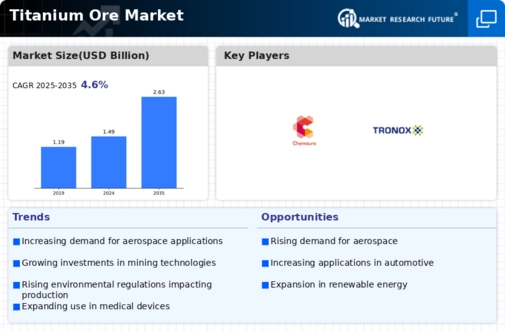Market Analysis
In-depth Analysis of Titanium Ore Market Industry Landscape
The market dynamics of the titanium ore market are influenced by various factors that impact its supply, demand, and pricing. Titanium ore, often referred to as ilmenite, rutile, or titanium slag, is a critical raw material in the production of titanium dioxide, which is primarily used in the manufacturing of paints, coatings, plastics, and other industrial products.
One of the primary drivers of market dynamics is the global demand for titanium dioxide. As economies grow and industrialization spreads, the demand for titanium dioxide increases, driving up the demand for titanium ore. Emerging markets, particularly in Asia-Pacific regions like China and India, have been significant contributors to this demand due to their rapid urbanization and infrastructure development.
On the supply side, the availability of titanium ore is influenced by factors such as geological reserves, mining technologies, and environmental regulations. Countries with substantial titanium ore reserves, such as Australia, South Africa, and China, play a significant role in supplying the global market. However, geopolitical factors, trade policies, and mining regulations in these countries can also impact the availability of titanium ore.
Technological advancements in mining and processing techniques also affect market dynamics. Innovations in extraction methods, such as the development of more efficient dredging and mineral separation technologies, can increase the supply of titanium ore and lower production costs. Conversely, disruptions in mining operations due to technical issues or labor disputes can lead to supply shortages and price fluctuations.
Environmental regulations and sustainability concerns are increasingly shaping market dynamics in the titanium ore industry. Mining operations are subject to scrutiny over their environmental impact, particularly in ecologically sensitive areas or regions with indigenous populations. Concerns about carbon emissions, water usage, and land rehabilitation are prompting companies to adopt more sustainable practices, which can affect production costs and supply chains.
Surging demand for the product from various industries such as electrical, aerospace and defense owing to corrosion resistance is driving the market growth.
Market dynamics in the titanium ore industry are also influenced by macroeconomic factors such as currency exchange rates, inflation, and economic growth. Fluctuations in currency values can affect the competitiveness of titanium ore exports and imports, while changes in economic conditions can impact consumer demand for products containing titanium dioxide.
Trade policies and tariffs imposed by governments can also disrupt the titanium ore market. Trade disputes between major economies, such as the United States and China, have led to tariffs on titanium ore and titanium dioxide products, affecting global supply chains and pricing dynamics. Additionally, trade agreements and alliances between countries can create opportunities for market growth or barriers to entry for new players.





Leave a Comment